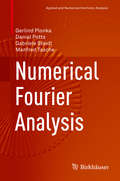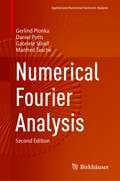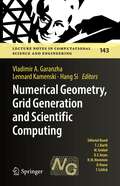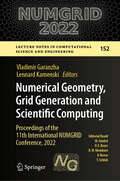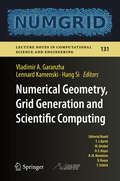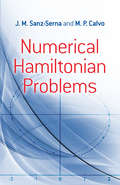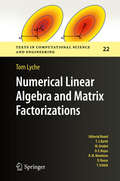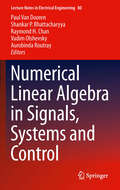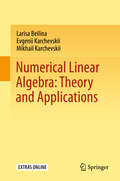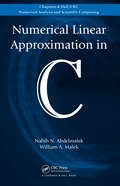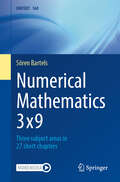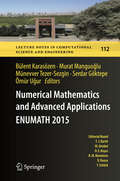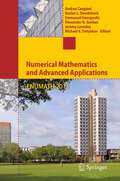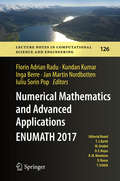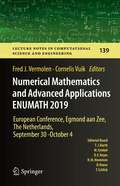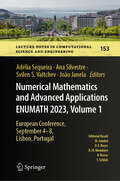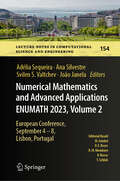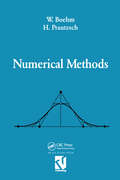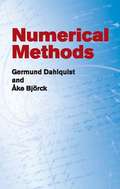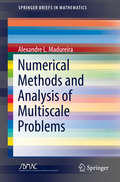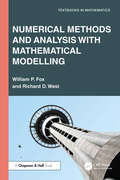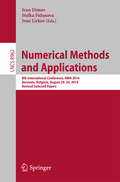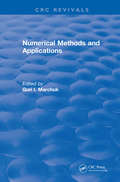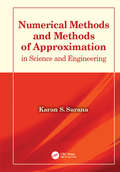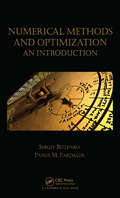- Table View
- List View
Numerical Fourier Analysis (Applied and Numerical Harmonic Analysis)
by Daniel Potts Gerlind Plonka Gabriele Steidl Manfred TascheThis book offers a unified presentation of Fourier theory and corresponding algorithms emerging from new developments in function approximation using Fourier methods. It starts with a detailed discussion of classical Fourier theory to enable readers to grasp the construction and analysis of advanced fast Fourier algorithms introduced in the second part, such as nonequispaced and sparse FFTs in higher dimensions. Lastly, it contains a selection of numerical applications, including recent research results on nonlinear function approximation by exponential sums. The code of most of the presented algorithms is available in the authors’ public domain software packages. Students and researchers alike benefit from this unified presentation of Fourier theory and corresponding algorithms.
Numerical Fourier Analysis (Applied and Numerical Harmonic Analysis)
by Daniel Potts Gerlind Plonka Gabriele Steidl Manfred TascheNew technological innovations and advances in research in areas such as spectroscopy, computer tomography, signal processing, and data analysis require a deep understanding of function approximation using Fourier methods. To address this growing need, this monograph combines mathematical theory and numerical algorithms to offer a unified and self-contained presentation of Fourier analysis. The first four chapters of the text serve as an introduction to classical Fourier analysis in the univariate and multivariate cases, including the discrete Fourier transforms, providing the necessary background for all further chapters. Next, chapters explore the construction and analysis of corresponding fast algorithms in the one- and multidimensional cases. The well-known fast Fourier transforms (FFTs) are discussed, as well as recent results on the construction of the nonequispaced FFTs, high-dimensional FFTs on special lattices, and sparse FFTs. An additional chapter is devoted to discrete trigonometric transforms and Chebyshev expansions. The final two chapters consider various applications of numerical Fourier methods for improved function approximation, including Prony methods for the recovery of structured functions.This new edition has been revised and updated throughout, featuring new material on a new Fourier approach to the ANOVA decomposition of high-dimensional trigonometric polynomials; new research results on the approximation errors of the nonequispaced fast Fourier transform based on special window functions; and the recently developed ESPIRA algorithm for recovery of exponential sums, among others.Numerical Fourier Analysis will be of interest to graduate students and researchers in applied mathematics, physics, computer science, engineering, and other areas where Fourier methods play an important role in applications.
Numerical Geometry, Grid Generation and Scientific Computing: Proceedings of the 10th International Conference, NUMGRID 2020 / Delaunay 130, Celebrating the 130th Anniversary of Boris Delaunay, Moscow, Russia, November 2020 (Lecture Notes in Computational Science and Engineering #143)
by Vladimir A. Garanzha Lennard Kamenski Hang SiThe focus of these conference proceedings is on research, development, and applications in the fields of numerical geometry, scientific computing and numerical simulation, particularly in mesh generation and related problems. In addition, this year’s special focus is on Delaunay triangulations and their applications, celebrating the 130th birthday of Boris Delaunay. In terms of content, the book strikes a balance between engineering algorithms and mathematical foundations. It presents an overview of recent advances in numerical geometry, grid generation and adaptation in terms of mathematical foundations, algorithm and software development and applications. The specific topics covered include: quasi-conformal and quasi-isometric mappings, hyperelastic deformations, multidimensional generalisations of the equidistribution principle, discrete differential geometry, spatial and metric encodings, Voronoi-Delaunay theory for tilings and partitions, duality in mathematical programming and numerical geometry, mesh-based optimisation and optimal control methods. Further aspects examined include iterative solvers for variational problems and algorithm and software development. The applications of the methods discussed are multidisciplinary and include problems from mathematics, physics, biology, chemistry, material science, and engineering.
Numerical Geometry, Grid Generation and Scientific Computing: Proceedings of the 11th International NUMGRID Conference, 2022 (Lecture Notes in Computational Science and Engineering #152)
by Lennard Kamenski Vladimir GaranzhaThis volume presents a selection of papers presented at the 11th International Conference on Numerical Geometry, Grid Generation, and Scientific Computing held December 12–14, 2022 in memory of Sergei Alexandrovich Ivanenko. The conference focuses on Voronoi-Delaunay theory and algorithms for tilings and partitions, mesh deformation and optimization, equidistribution principle, error analysis, discrete differential geometry, duality in mathematical programming and numerical geometry, mesh-based optimization and optimal control methods, iterative solvers for variational problems, as well as algorithm and software development. The book provides an overview of recent advances in mesh generation and adaptation in terms of mathematical foundations, algorithm and software development, and applications.
Numerical Geometry, Grid Generation and Scientific Computing: Proceedings of the 9th International Conference, NUMGRID 2018 / Voronoi 150, Celebrating the 150th Anniversary of G.F. Voronoi, Moscow, Russia, December 2018 (Lecture Notes in Computational Science and Engineering #131)
by Vladimir A. Garanzha Lennard Kamenski Hang SiThe focus of these conference proceedings is on research, development, and applications in the fields of numerical geometry, scientific computing and numerical simulation, particularly in mesh generation and related problems. In addition, this year’s special focus is on Voronoi diagrams and their applications, celebrating the 150th birthday of G.F. Voronoi. In terms of content, the book strikes a balance between engineering algorithms and mathematical foundations. It presents an overview of recent advances in numerical geometry, grid generation and adaptation in terms of mathematical foundations, algorithm and software development and applications. The specific topics covered include: quasi-conformal and quasi-isometric mappings, hyperelastic deformations, multidimensional generalisations of the equidistribution principle, discrete differential geometry, spatial and metric encodings, Voronoi-Delaunay theory for tilings and partitions, duality in mathematical programming and numerical geometry, mesh-based optimisation and optimal control methods. Further aspects examined include iterative solvers for variational problems and algorithm and software development. The applications of the methods discussed are multidisciplinary and include problems from mathematics, physics, biology, chemistry, material science, and engineering.
Numerical Hamiltonian Problems (Dover Books on Mathematics)
by J.M. Sanz-Serna M. P. CalvoThis advanced text explores a category of mathematical problems that occur frequently in physics and other sciences. Five preliminary chapters make the book accessible to students without extensive background in this area. Topics include Hamiltonian systems, symplecticness, numerical methods, order conditions, and implementation.The heart of the book, chapters 6 through 10, explores symplectic integration, symplectic order conditions, available symplectic methods, numerical experiments, and properties of symplectic integrators. The final four chapters contain more advanced material: generating functions, Lie formalism, high-order methods, and extensions. Many numerical examples appear throughout the text.
Numerical Linear Algebra and Matrix Factorizations (Texts in Computational Science and Engineering #22)
by Tom LycheAfter reading this book, students should be able to analyze computational problems in linear algebra such as linear systems, least squares- and eigenvalue problems, and to develop their own algorithms for solving them. Since these problems can be large and difficult to handle, much can be gained by understanding and taking advantage of special structures. This in turn requires a good grasp of basic numerical linear algebra and matrix factorizations. Factoring a matrix into a product of simpler matrices is a crucial tool in numerical linear algebra, because it allows us to tackle complex problems by solving a sequence of easier ones. The main characteristics of this book are as follows: It is self-contained, only assuming that readers have completed first-year calculus and an introductory course on linear algebra, and that they have some experience with solving mathematical problems on a computer. The book provides detailed proofs of virtually all results. Further, its respective parts can be used independently, making it suitable for self-study. The book consists of 15 chapters, divided into five thematically oriented parts. The chapters are designed for a one-week-per-chapter, one-semester course. To facilitate self-study, an introductory chapter includes a brief review of linear algebra.
Numerical Linear Algebra in Signals, Systems and Control
by Aurobinda Routray Paul Van Dooren Raymond H. Chan Shankar P. Bhattacharyya Vadim OlshevskyThe purpose of Numerical Linear Algebra in Signals, Systems and Control is to present an interdisciplinary book, blending linear and numerical linear algebra with three major areas of electrical engineering: Signal and Image Processing, and Control Systems and Circuit Theory. Numerical Linear Algebra in Signals, Systems and Control will contain articles, both the state-of-the-art surveys and technical papers, on theory, computations, and applications addressing significant new developments in these areas. The goal of the volume is to provide authoritative and accessible accounts of the fast-paced developments in computational mathematics, scientific computing, and computational engineering methods, applications, and algorithms. The state-of-the-art surveys will benefit, in particular, beginning researchers, graduate students, and those contemplating to start a new direction of research in these areas. A more general goal is to foster effective communications and exchange of information between various scientific and engineering communities with mutual interests in concepts, computations, and workable, reliable practices.
Numerical Linear Algebra: Theory and Applications
by Larisa Beilina Evgenii Karchevskii Mikhail KarchevskiiThis book combines a solid theoretical background in linear algebra with practical algorithms for numerical solution of linear algebra problems. Developed from a num- ber of courses taught repeatedly by the authors, the material covers topics like matrix algebra, theory for linear systems of equations, spectral theory, vector and matrix norms combined with main direct and iterative numerical methods, least squares problems, and eigenproblems. Numerical algorithms illustrated by computer programs written in MATLAB#65533; are also provided as supplementary material on SpringerLink to give the reader a better understanding of professional numerical software for the solution of real-life problems. Perfect for a one- or two-semester course on numerical linear algebra, matrix computation, and large sparse matrices, this text will interest students at the advanced undergraduate or graduate level.
Numerical Linear Approximation in C
by Nabih Abdelmalek William A. MalekIllustrating the relevance of linear approximation in a variety of fields, Numerical Linear Approximation in C presents a unique collection of linear approximation algorithms that can be used to analyze, model, and compress discrete data. Developed by the lead author, the algorithms have been successfully applied to several engineering proje
Numerical Mathematics 3x9: Three subject areas in 27 short chapters (UNITEXT #160)
by Sören BartelsThis book provides an introduction to methods for practically solving mathematical problems, such as solving systems of linear equations, determining eigenvalues, approximating and integrating functions, solving nonlinear equations, and the approximate solution of ordinary differential equations. It consists of three parts: • Systems of linear equations, eigenvalue problems and optimisation • Interpolation, quadrature and nonlinear equations • Initial value problems and Hamiltonian systems Each of these parts is divided into nine short chapters and corresponds approximately to the scope of a two-hour lecture over one semester. Basic knowledge of linear algebra and analysis as well as elementary programming experience are assumed. Results of analysis are only used in the second and third part of the book. Learning objectives, self-assessment tests and exemplary applications at the end of each chapter are intended to deepen the understanding of the presented material. The last chapters of the book contain extensive collections of exercises, detailed descriptions for programming projects, introductions to the programming languages MATLAB, C++ and Python, compilations of the most important results from linear algebra and analysis, some example programs, a list of further topics as well as detailed literature references. The book is aimed at undergraduate students of mathematics as well as engineering and natural sciences. The translation of this book was done with the help of artificial intelligence. A subsequent human revision was done primarily in terms of content.
Numerical Mathematics and Advanced Applications ENUMATH 2015
by Bülent Karasözen Murat Manguoğlu Münevver Tezer-Sezgin Serdar Göktepe Ömür UğurThe European Conference on Numerical Mathematics and Advanced Applications (ENUMATH), held every 2 years, provides a forum for discussing recent advances in and aspects of numerical mathematics and scientific and industrial applications. The previous ENUMATH meetings took place in Paris (1995), Heidelberg (1997), Jyvaskyla (1999), Ischia (2001), Prague (2003), Santiago de Compostela (2005), Graz (2007), Uppsala (2009), Leicester (2011) and Lausanne (2013). This book presents a selection of invited and contributed lectures from the ENUMATH 2015 conference, which was organised by the Institute of Applied Mathematics (IAM), Middle East Technical University, Ankara, Turkey, from September 14 to 18, 2015. It offers an overview of central recent developments in numerical analysis, computational mathematics, and applications in the form of contributions by leading experts in the field.
Numerical Mathematics and Advanced Applications 2011
by Alexander N. Gorban Andrea Cangiani Emmanuil Georgoulis Jeremy Levesley Michael V. Tretyakov Ruslan L DavidchackThe European Conferences on Numerical Mathematics and Advanced Applications (ENUMATH) are a series of conferences held every two years to provide a forum for discussion of new trends in numerical mathematics and challenging scientific and industrial applications at the highest level of international expertise. ENUMATH 2011 was hosted by the University of Leicester (UK) from the 5th to 9th September 2011. This proceedings volume contains more than 90 papers by speakers of the conference and gives an overview of recent developments in scientific computing, numerical analysis, and practical use of modern numerical techniques and algorithms in various applications. New results on finite element methods, multiscale methods, numerical linear algebra, and finite difference schemes are presented. A range of applications include computational problems from fluid dynamics, materials, image processing, and molecular dynamics.
Numerical Mathematics and Advanced Applications ENUMATH 2017 (Lecture Notes in Computational Science and Engineering #126)
by Jan Martin Nordbotten Florin Adrian Radu Kundan Kumar Inga Berre Iuliu Sorin PopThis book collects many of the presented papers, as plenary presentations, mini-symposia invited presentations, or contributed talks, from the European Conference on Numerical Mathematics and Advanced Applications (ENUMATH) 2017. The conference was organized by the University of Bergen, Norway from September 25 to 29, 2017. Leading experts in the field presented the latest results and ideas in the designing, implementation, and analysis of numerical algorithms as well as their applications to relevant, societal problems.ENUMATH is a series of conferences held every two years to provide a forum for discussing basic aspects and new trends in numerical mathematics and scientific and industrial applications. These discussions are upheld at the highest level of international expertise. The first ENUMATH conference was held in Paris in 1995 with successive conferences being held at various locations across Europe, including Heidelberg (1997), Jyvaskyla (1999), lschia Porto (2001), Prague (2003), Santiago de Compostela (2005), Graz (2007), Uppsala (2009), Leicester (2011), Lausanne (2013), and Ankara (2015).
Numerical Mathematics and Advanced Applications ENUMATH 2019: European Conference, Egmond aan Zee, The Netherlands, September 30 - October 4 (Lecture Notes in Computational Science and Engineering #139)
by Cornelis Vuik Fred J. VermolenThis book gathers outstanding papers presented at the European Conference on Numerical Mathematics and Advanced Applications (ENUMATH 2019). The conference was organized by Delft University of Technology and was held in Egmond aan Zee, the Netherlands, from September 30 to October 4, 2019. Leading experts in the field presented the latest results and ideas regarding the design, implementation and analysis of numerical algorithms, as well as their applications to relevant societal problems.ENUMATH is a series of conferences held every two years to provide a forum for discussing basic aspects and new trends in numerical mathematics and scientific and industrial applications, all examined at the highest level of international expertise. The first ENUMATH was held in Paris in 1995, with successive installments at various sites across Europe, including Heidelberg (1997), Jyvaskyla (1999), lschia Porto (2001), Prague (2003), Santiago de Compostela (2005), Graz (2007), Uppsala (2009), Leicester (2011), Lausanne (2013), Ankara (2015) and Bergen (2017).
Numerical Mathematics and Advanced Applications ENUMATH 2023, Volume 1: European Conference, September 4-8, Lisbon, Portugal (Lecture Notes in Computational Science and Engineering #153)
by Adélia Sequeira Ana Silvestre Svilen S. Valtchev João JanelaThis book gathers outstanding papers presented at the European Conference on Numerical Mathematics and Advanced Applications, ENUMATH 2023. The conference was held in Lisbon, Portugal, in September 2023. Leading experts in the field presented the latest results and ideas regarding the design, implementation and analysis of numerical algorithms, as well as their applications to relevant societal problems. ENUMATH is a series of conferences held every two years to provide a forum for discussing basic aspects and new trends in numerical mathematics and its scientific and industrial applications, all examined at the highest level of international expertise. The first ENUMATH was held in Paris in 1995, with successive installments at various sites across Europe, including Heidelberg (1997), Jyvaskyla (1999), lschia Porto (2001), Prague (2003), Santiago de Compostela (2005), Graz (2007), Uppsala (2009), Leicester (2011), Lausanne (2013), Ankara (2015), Bergen (2017), and Egmond aan Zee (2019).
Numerical Mathematics and Advanced Applications ENUMATH 2023, Volume 2: European Conference, September 4-8, Lisbon, Portugal (Lecture Notes in Computational Science and Engineering #154)
by Adélia Sequeira Ana Silvestre Svilen S. Valtchev João JanelaThis book gathers outstanding papers presented at the European Conference on Numerical Mathematics and Advanced Applications, ENUMATH 2023. The conference was held in Lisbon, Portugal, in September 2023. Leading experts in the field presented the latest results and ideas regarding the design, implementation and analysis of numerical algorithms, as well as their applications to relevant societal problems. ENUMATH is a series of conferences held every two years to provide a forum for discussing basic aspects and new trends in numerical mathematics and its scientific and industrial applications, all examined at the highest level of international expertise. The first ENUMATH was held in Paris in 1995, with successive installments at various sites across Europe, including Heidelberg (1997), Jyvaskyla (1999), lschia Porto (2001), Prague (2003), Santiago de Compostela (2005), Graz (2007), Uppsala (2009), Leicester (2011), Lausanne (2013), Ankara (2015), Bergen (2017), and Egmond aan Zee (2019).
Numerical Methods
by Wolfgang BoehmThis book is written for engineers and other practitioners using numerical methods in their work and serves as a textbook for courses in applied mathematics and numerical analysis.
Numerical Methods (Dover Books on Mathematics)
by Germund Dahlquist Åke BjörckPractical text strikes fine balance between students' requirements for theoretical treatment and needs of practitioners, with best methods for large- and small-scale computing. Prerequisites are minimal (calculus, linear algebra, and preferably some acquaintance with computer programming). Text includes many worked examples, problems, and an extensive bibliography.
Numerical Methods and Analysis of Multiscale Problems
by Alexandre L. MadureiraThis book is about numerical modeling of multiscale problems, and introduces several asymptotic analysis and numerical techniques which are necessary for a proper approximation of equations that depend on different physical scales. Aimed at advanced undergraduate and graduate students in mathematics, engineering and physics - or researchers seeking a no-nonsense approach -, it discusses examples in their simplest possible settings, removing mathematical hurdles that might hinder a clear understanding of the methods. The problems considered are given by singular perturbed reaction advection diffusion equations in one and two-dimensional domains, partial differential equations in domains with rough boundaries, and equations with oscillatory coefficients. This work shows how asymptotic analysis can be used to develop and analyze models and numerical methods that are robust and work well for a wide range of parameters.
Numerical Methods and Analysis with Mathematical Modelling (Textbooks in Mathematics)
by William P. Fox Richard D. WestWhat sets Numerical Methods and Analysis with Mathematical Modelling apart are the modelling aspects utilizing numerical analysis (methods) to obtain solutions. The authors cover first the basic numerical analysis methods with simple examples to illustrate the techniques and discuss possible errors. The modelling prospective reveals the practical relevance of the numerical methods in context to real-world problems.At the core of this text are the real-world modelling projects. Chapters are introduced and techniques are discussed with common examples. A modelling scenario is introduced that will be solved with these techniques later in the chapter. Often, the modelling problems require more than one previously covered technique presented in the book.Fundamental exercises to practice the techniques are included. Multiple modelling scenarios per numerical methods illustrate the applications of the techniques introduced. Each chapter has several modelling examples that are solved by the methods described within the chapter.The use of technology is instrumental in numerical analysis and numerical methods. In this text, Maple, Excel, R, and Python are illustrated. The goal is not to teach technology but to illustrate its power and limitations to perform algorithms and reach conclusions.This book fulfills a need in the education of all students who plan to use technology to solve problems whether using physical models or true creative mathematical modeling, like discrete dynamical systems.
Numerical Methods and Applications
by Stefka Fidanova Ivan Dimov Ivan LirkovThis book constitutes the thoroughly refereed post-conference proceedings of the 8th International Conference on Numerical Methods and Applications, NMA 2014, held in Borovets, Bulgaria, in August 2014. The 34 revised full papers presented were carefully reviewed and selected from 56 submissions for inclusion in this book. The papers are organized in the following topical sections: Monte Carlo and quasi-Monte Carlo methods; metaheuristics for optimization problems; advanced numerical methods for scientific computing; advanced numerical techniques for PDEs and applications; solving large engineering and scientific problems with advanced mathematical models; numerical simulations and back analysis in civil and mechanical engineering.
Numerical Methods and Applications (CRC Press Revivals)
by Guri I. MarchukThis book presents new original numerical methods that have been developed to the stage of concrete algorithms and successfully applied to practical problems in mathematical physics. The book discusses new methods for solving stiff systems of ordinary differential equations, stiff elliptic problems encountered in problems of composite material mechanics, Navier-Stokes systems, and nonstationary problems with discontinuous data. These methods allow natural paralleling of algorithms and will find many applications in vector and parallel computers.
Numerical Methods and Methods of Approximation in Science and Engineering
by Karan S. SuranaNumerical Methods and Methods of Approximation in Science and Engineering prepares students and other readers for advanced studies involving applied numerical and computational analysis. Focused on building a sound theoretical foundation, it uses a clear and simple approach backed by numerous worked examples to facilitate understanding of numerical methods and their application. Readers will learn to structure a sequence of operations into a program, using the programming language of their choice; this approach leads to a deeper understanding of the methods and their limitations. The text features highlighted examples, numerous problems, and a complete Solutions Manual for instructors.
Numerical Methods and Optimization: An Introduction (Chapman & Hall/CRC Numerical Analysis and Scientific Computing Series)
by Panos M. Pardalos Sergiy ButenkoFor students in industrial and systems engineering (ISE) and operations research (OR) to understand optimization at an advanced level, they must first grasp the analysis of algorithms, computational complexity, and other concepts and modern developments in numerical methods. Satisfying this prerequisite, Numerical Methods and Optimization: An Intro
